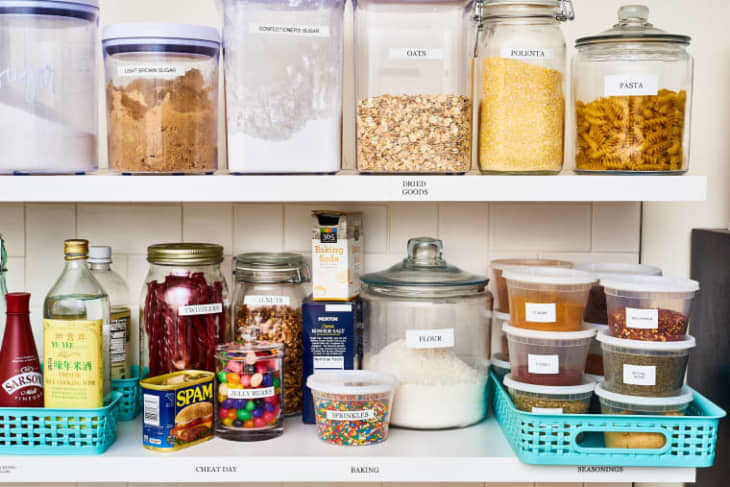9 Things You Can Label to Make Life Easier and Stay Organized Forever

Labeling is the capstone of any organization system that will stand the test of time. Labeling points both others and yourself to where things can be found and, more importantly, to where things should be put away. This not only keeps things in order but saves you brain energy by eliminating the need to search for where things are and where things go.
Once you realize how much time and energy labeling can save, you’ll be eager to put that label maker to work. True, you may not want labels showing out in the open spaces of your home, but there are clever ways to conceal labels that still allow them to do their very important job of guiding everything into just the right spot with no errant stowaways.
To indefinitely extend the time all your organized spaces stay that way, consider labeling the following:
1. Refrigerator shelves, bins, and drawers
By labeling zones in your refrigerator, everyone who puts things away and gets things out of the fridge knows just where to put things and where to find things. Not only will labels maintain inner fridge order, but you’ll find yourself saving money by not buying duplicate items or having “lost” items go to waste when they expire before you use them. Label shelves, door bins, drawers, and any freestanding bins you use to stow items in the fridge.
2. Storage bins
Whether they’re opaque or see-through, labeling bins reduces visual noise and helps focus your attention right where you need it when you’re getting something out or putting something away. With labels, you’ll be less tempted to stick things wherever they happen to fit, which slowly erodes the order you worked hard to create. Label every kind of storage bin, from the oversized ones in the garage to the shoebox-sized ones under your bathroom sink and in the craft cabinet.
3. The laundry hamper
This is less of a storage issue and more a way to keep order and save time. If you have a laundry sorter, label the different compartments. Ours has four compartments and labels that read: hand wash, darks, whites, lights. Labeling your dirty laundry keeps you from having to re-sort dirty laundry.
4. Drawers
All kinds of drawers can better serve their storage purposes when they are labeled. Unless they are within a closet or cabinet (or the fridge), you probably don’t want the labels to show on the outside. Place the labels on the upper lip of the drawer so you can see what belongs where when the drawer is open. All kinds of drawers can be labeled, including ones in a desk, dresser, and pantry or fridge.
5. Drawer dividers
Even organizers within drawers can be labeled. Again, this particularly applies to organizers in kitchen or dresser drawers. For instance, you can label sections of kitchen drawer organizers with things like baking tools or spatulas and in-drawer clothing divider inserts with things like winter socks or bikinis. Labels are especially useful when a collection of smaller things is stored together in one compartment or area so you can be sure to keep similar things together and not jumbled up with other small items.
6. Pantry zones
There are several kinds of labels that are useful in the pantry. Label containers so you know what kind of flour is in which container. Label shelves so you know what to put where and where to look for something (for instance, canned vegetables and beans on one shelf and canned milk and baking supplies, where you’d put things like condensed milk, pumpkin puree, and canned cherries for pie filling). Label any baskets or bins you have so you can know which to retrieve without looking in all of them or mixing categories of things up. Lastly, label other storage solutions you have in your pantry, such as turntables (one may hold vinegars and oils while another serves up spreads like peanut butter and Nutella).
7. Linen closet shelves
Carefully arranged linen closets, with fluffy towels folded to the same size are pleasing to behold. But it doesn’t take long for everything that’s lined up just so to become a ruffled-through, toppled over mass of terrycloth and cotton as family members search for hand towels or bedding. Label shelves so everyone knows where to grab or stow the hand towels, bath towels, and pillow cases. Additionally, you may want to label shelves according to the rooms the linens belong in, the season, or who they are used for (guests vs. family).
8. Hooks
Hooks are so useful for hanging tools in the cleaning closet or adding extra and inexpensive storage on any vertical surface in the house, whether it’s the walls or the inside of cabinet doors. Labeling lets everyone know what goes on the hook. For instance, I have hooks on the inside of the cabinets under my kitchen sink with labels that read bottle brushes and others that read table and hands and faces to designate the rags we use for specific purposes. Other hooks that could use labels are ones you use to hang various sets of keys and those in the mudroom (if you’re interested in keeping bags, hats, and leashes in their own spots, for instance).
9. Spices
Whether you keep them in a drawer, in the pantry, or in cupboards, nothing is quite as satisfying to look at in the kitchen as spices that have been decanted into uniform containers and labeled. Using the same size and type of container keeps all your spices visible and avoids a cluttered look. In addition, this allows you to buy spices in bulk and only keep a reasonable amount handy when you cook. Labeling them so you don’t accidentally mix up, say, nutmeg and cumin is an obvious necessity.